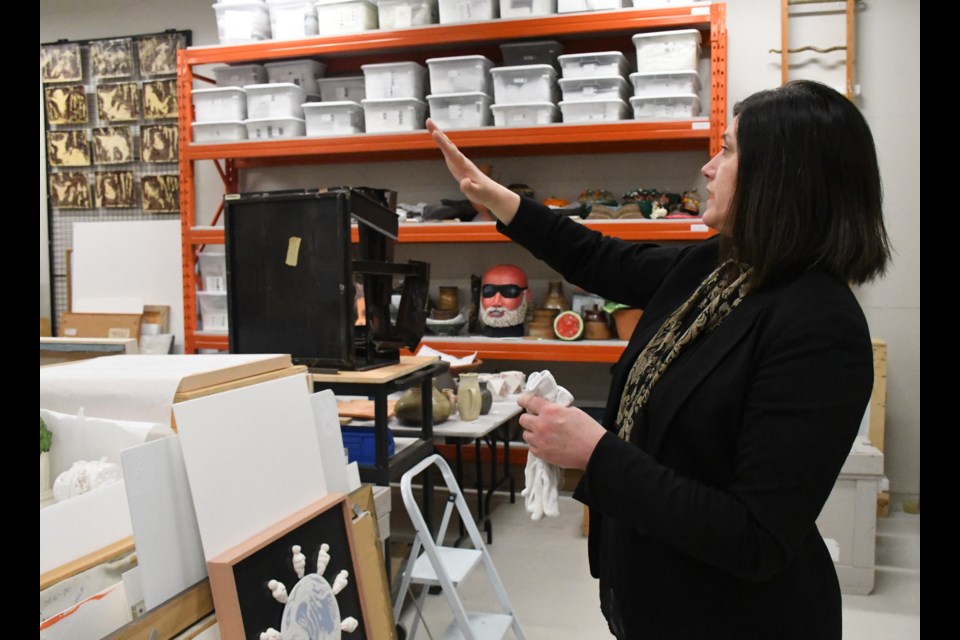MOOSE JAW — From abstract ceramics to sculptures to everyday artifacts, the Moose Jaw Museum and Art Gallery (MJMAG) houses thousands of items that reflect the history of the community, Saskatchewan and Canada.
This story — part 2 of 2 —
Abstraction
The strength of the MJMAG’s two-dimensional art collection reflects the strength of Saskatchewan’s art history since the venue has many paintings of folk art, landscape and abstraction, with the latter a major focus in the province in the 1950s and 1960s, said Jennifer McRorie, curator/director of the MJMAG.
“I don’t know if many people know how important abstraction was to Saskatchewan art history, that we had some of the leading abstract (artists) in Canada here in this province,” she remarked. “It’s not always a period of art history that people may understand or appreciate, but it’s an important part of our history.”
Whenever the MJMAG receives a donation of abstract work, its acquisitions committee discusses whether to accept more of such pieces. Usually, the consensus is it should accept the artwork since it already has so much of that type.
The art museum holds many Canadian-made abstract pieces because it believes they broaden the discussion and context for Saskatchewan abstract works, with one piece worth roughly $45,000, the curator said.
Joan Rankin, a Moose Jaw artist whose works the gallery holds, was heavily involved in abstract art and travelled to Emma Lake — a summer campus for the University of Saskatchewan from the 1950s to 1970s — north of Prince Albert to attend two-week art workshops that included New York City art critics, McRorie recalled.
Rankin attended a workshop in 1962 that also featured Clement Greenberg, who was “the art critic of the New York art world, and therefore, the world,” the curator said.
While working on one project, Greenberg approached the Moose Javian and told her to leave an unpainted strip of canvas running down the right side of the piece — and she did.
The MJMAG possesses that piece, which is great since it was pivotal to Rankin’s career and led to Greenberg inviting her to New York City, where she met some of the leading artists of that time, McRorie continued.
The art museum curator believes Rankin could have had a lucrative career in The Big Apple, but her husband, who dusted crops for a living, died during a crash, leaving her to raise their two children, one of whom was a newborn.
However, the abstract artist kept working and helped establish the art education program in Moose Jaw schools.
Another Saskatchewan artist who dabbled in abstraction was Dorothy Knowles, “a really revered landscape artist” who attended the same summer workshop as Rankin, said McRorie.
Knowles was working on a painting — “The Bluff” — when Greenberg saw it and suggested she approach it differently. Specifically, since she had drawn the landscape in the middle, he recommended that she should fade the top and bottom into abstraction while retaining the landscape aspect.
“I think it’s really impressive that Moose Jaw has this pivotal piece in our collection. It was pivotal for (Knowles’) art career,” McRorie said, adding The Bluff hung in her office for several years before she moved it to the vault for “respite” so it could be better preserved.
Other artists who focused on abstraction — and whose paintings the MJMAG possesses — include Aboriginal painters Bob Boyer, Neil McLeod and Art McKay, and William Perehudoff, Knowles’ husband.
Paintings, sculptures, ceramics, and artists
Some notable artists whose works — ceramic, metal, sculpture, painting, pen and ink, woodcuts, or watercolour— are in the vault and whose backstories McRorie discussed include Jerry Didur, Fred Clark, Jerry Kaiser, Anthony Thorn, Alex Cameron, Molly Lenhardt, William Ronald, Gerald (Jerry) Jessop, Carl Bean, Gus Froese, Dale Klein, Kenneth Lochhead, McGregor Hone, Fred Varley, Harold Treherne, David Weber, Bob Christie, Augustus Kenderdine, Tim Fenton, Alice McCready, William Carter, William McCarger, Jahan Makan and Vaughan Grayson.
The MJMAG’s art collection has a significant volume of ceramics, especially from British and Japanese creators, although its focus is mainly on sculptures from Saskatchewan and Canadian artists, along with some pottery, McRorie said.
McRorie noted that several pieces need better conservation since the paint is slumping or cracking. She pointed to one painting by Iris Hauser that had a spider web-type spiral, indicating something had slammed into it — or, more likely, someone had punched it because of the artwork’s subject.
The MJMAG keeps the art vault at 20.7 degrees Celsius and the humidity at 47 per cent. While both are necessary to preserve the pieces, the latter is more important since any fluctuations in humidity can damage the canvases, which regularly expand and contract.
McRorie thought it was interesting that when artists and studios donate some pieces, it’s easy to see the wrinkling in the canvases because the humidity changed where they stored the works.
“… a canvas, if it’s stretched well, should be almost like a drum,” she added.
For more information about the Moose Jaw Museum and Art Gallery, visit .




